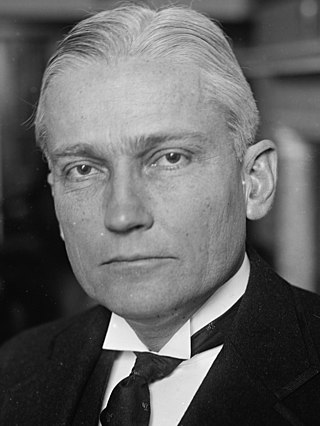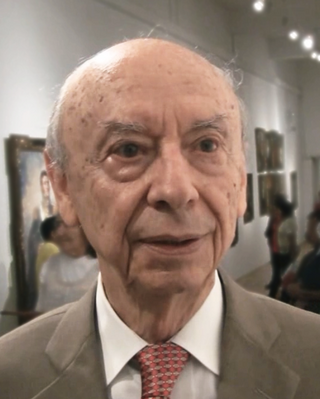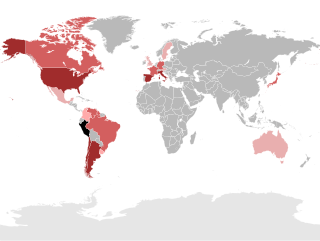
Machu Picchu is a 15th-century Inca citadel located in the Eastern Cordillera of southern Peru on a mountain ridge at 2,430 meters (7,970 ft). Often referred to as the "Lost City of the Incas", it is the most familiar icon of the Inca Empire. It is located in the Machupicchu District within the Urubamba Province above the Sacred Valley, which is 80 kilometers (50 mi) northwest of the city of Cusco. The Urubamba River flows past it, cutting through the Cordillera and creating a canyon with a subtropical mountain climate.

Alejandro Celestino Toledo Manrique is a Peruvian former politician who served as President of Peru, from 2001 to 2006. He gained international prominence after leading the opposition against president Alberto Fujimori, who held the presidency from 1990 to 2000. On 21 October 2024 he was sentenced to 20 years in prison for taking $35 million dollars in bribes to award the Brazilian company Odebrecht with a highway contract.

Hiram Bingham III was an American academic, explorer and politician. In 1911, he publicized the existence of the Inca citadel of Machu Picchu which he rediscovered with the guidance of local indigenous farmers. Later, Bingham served as the 69th Governor of Connecticut for a single day in 1925—the shortest term in history. He had been elected in 1924 as governor, but was also elected to the Senate and chose that position. He served as a member of the United States Senate until 1933.

PeruRail is a railway operator providing tourist, freight, and charter services in southern Peru. It was founded in 1999 by two Peruvian entrepreneurs and the British company Sea Containers.
Peruvian art has its origin in the Andean civilizations. These civilizations rose in the territory of modern Peru before the arrival of the Spanish.

Hilaria Supa Huamán is a Peruvian politician, human rights activist, and an active member of several Indigenous women's organizations in Peru and around the world. She was a Congresswoman representing Cusco from 2006-2011, as a member of Ollanta Humala's Partido Nacionalista Peruano party.

Johan Reinhard is an American anthropologist and archaeologist. Currently, he is a Research Professor at Future Generations University. formerly Explorer-in-Residence at the National Geographic Society. He is also a senior research fellow at The Mountain Institute, a visiting professor at Catholic University, Salta, Argentina, an honorary professor of Catholic University, Arequipa, Peru.

Federico Kauffmann Doig is a Peruvian historian, archaeologist, and anthropologist. He has made great contributions to the study of the civilizations of Ancient Peru, particularly on the Chavín culture and the Chachapoya culture.

Peruvian architecture is the architecture carried out during any time in what is now Peru, and by Peruvian architects worldwide. Its diversity and long history spans from ancient Peru, the Inca Empire, Colonial Peru to the present day.

The Indigenous peoples of Peru or Native Peruvians comprise a large number of ethnic groups who inhabit territory in present-day Peru. Indigenous cultures developed here for thousands of years before the arrival of the Spanish in 1532.

Peruvians are the citizens of Peru. What is now Peru has been inhabited for several millennia by cultures such as the Caral before the Spanish conquest in the 16th century. Peruvian population decreased from an estimated 5–9 million in the 1520s to around 600,000 in 1620 mainly because of infectious diseases carried by the Spanish. Spaniards and Africans arrived in large numbers in 1532 under colonial rule, mixing widely with each other and with Native Peruvians. During the Republic, there has been a gradual immigration of European people. Chinese and Japanese arrived in large numbers at the end of the 19th century.

Since the 2000s, Tourism in Peru has made up the nation's third largest industry, behind fishing and mining. Tourism is directed towards archaeological monuments, ecotourism in the Peruvian Amazon, cultural tourism in colonial cities, gastronomic tourism, adventure tourism, and beach tourism. Iperú is the Peruvian national tourist office.

Israel–Peru relations are foreign relations and diplomatic ties between the State of Israel and the Republic of Peru. Both countries established diplomatic relations on 1 January 1958. Israel has an embassy in Lima. Peru has an embassy in Tel Aviv.

Pachamama is a goddess revered by the indigenous peoples of the Andes. In Inca mythology she is an "Earth Mother" type goddess, and a fertility goddess who presides over planting and harvesting, embodies the mountains, and causes earthquakes. She is also an ever-present and independent deity who has her own creative power to sustain life on Earth. Her shrines are hallowed rocks, or the boles of legendary trees, and her artists envision her as an adult female bearing harvests of potatoes or coca leaves. The four cosmological Quechua principles – Water, Earth, Sun, and Moon – claim Pachamama as their prime origin. Priests sacrifice offerings of llamas, cuy, and elaborate, miniature, burned garments to her. Pachamama is the mother of Inti the sun god, and Mama Killa the moon goddess. Mama Killa is said to be the wife of Inti.
Tilsa Tsuchiya Castillo was a Peruvian printmaker and painter known for her paintings of Peruvian myths and legends. She is considered one of the greatest exemplars of Peruvian painting, having won the prestigious Bienal of Teknoquimica Prize for painting. Her teacher, Ricardo Grau, had also been presented the Bienal award in a previous year. Tsuchiya graduated from the Escuela Nacional Superior Autónoma de Bellas Artes of Peru in 1959. Tsuchiya’s work addressed the contemporary issues of gender and identity and has been linked to earlier Surrealists.

The pacha is an Andean cosmological concept associating the physical world and space with time, and corresponding with the concept of space-time.

The Peru–Yale University dispute was a century-long conflict between the government of Peru and Yale University about the rightful ownership of Inca human remains and artifacts from Machu Picchu, an ancient Inca site high in the Peruvian Andes active c. 1420–1532. In the several years following his re-discovery of Machu Picchu in 1911, Yale explorer Hiram Bingham III removed thousands of objects – including pottery, stone tools, and human bones – from the archaeological site and brought them to New Haven, Connecticut. The circumstances of these transfers were disputed, with some, including Bingham, claiming that Yale agreed to borrow the artifacts for a period of 18 months to conduct studies. Peru attempted to regain the collection in the 1920s, but Yale resisted. Tensions rose between 2006 and 2010 with a lawsuit, activism by Peruvians and Yale alumni, and a plea to then–U.S. President Barack Obama by then–Peruvian President Alan Garcia. On November 19, 2010, Peru and Yale reached an agreement that the remains and artifacts would be returned. In early 2011, Yale and University of Cusco (UNSAAC) signed a further agreement that the two institutions would partner to create a museum and research center in Cusco. The museum, the Museo Machu Picchu, was opened to the public in November 2011. The collection is regarded by experts to be among the most valuable collections of Inca artifacts.

Lorenzo Sousa Debarbieri is an entrepreneur, businessman and author from Lima who oversees large privately held tourism and railway companies in Peru (Peru Belmond Hotels, PeruRail and Ferrocarril Transandino.
Richard Lewis Burger, Ph.D., is an archaeologist and anthropologist from the United States. He is currently a professor at Yale University and holds the positions of Charles J. MacCurdy Professor in the Anthropology Department, Chair of the Council on Archaeological Studies, and Curator in the Division of Anthropology at the Peabody Museum of Natural History. He has carried out archaeological excavations in the Peruvian Andes since 1975, publishing several books and many articles on Chavin culture, a pre-Hispanic civilization that developed in the northern Andean highlands of Peru from 1000 BC to 400 BC. Burger is married to Lucy Salazar, a Peruvian archaeologist and long time collaborator on many research projects. His former doctoral student Sabine Hyland has become well-known as an Andean anthropologist.

Dora Mayer was an activist, essayist, and intellectual, who championed the rights of indigenous people in Peru.

















